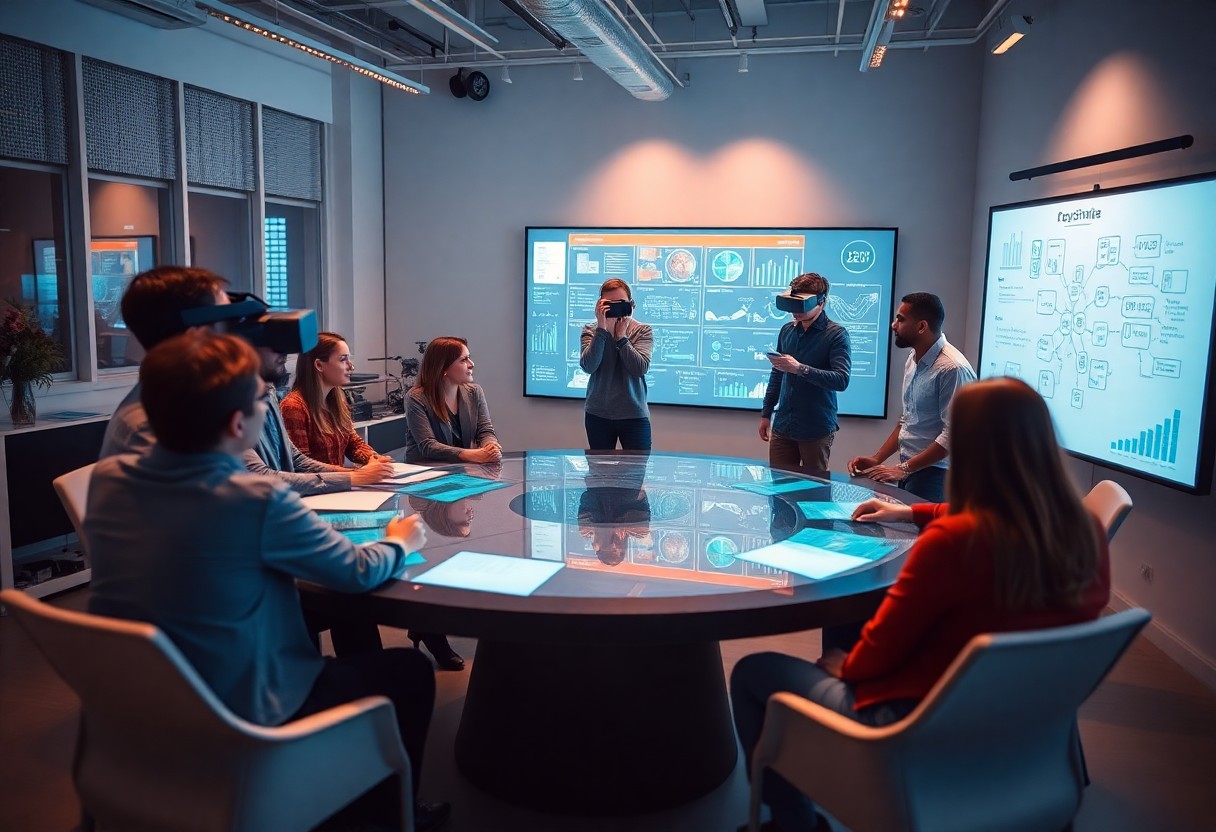With the rising influence of technology in your daily life, finding a balance between digital tools and human connection is imperative for your well-being and productivity. You might rely on apps for communication and task management, yet it’s vital to prioritize face-to-face interactions that foster collaboration and support. This blog post will guide you through effective strategies to harmonize these elements, ensuring you harness the benefits of digital advancements while nurturing your personal relationships and emotional health. Discover how to create a fulfilling work environment that emphasizes both efficiency and genuine connection.
Key Takeaways:
- Finding the right mix of digital tools and personal interaction is necessary for enhancing workplace productivity and employee well-being.
- Fostering an environment that prioritizes human connection can lead to improved collaboration and a stronger organizational culture.
- Regularly assessing the effectiveness of digital tools in facilitating communication can help organizations better align technology with their team’s needs.
The Digital Dilemma: Navigating Productivity and Isolation
Amidst the comfort of digital tools, a paradox emerges where efficiency often leads to a sense of isolation. While platforms enhance productivity by streamlining communication and automating tasks, they can also create emotional distance. As you rely more on screens for work, meaningful human interactions may diminish, leading to a sense of being connected yet profoundly alone. The challenge lies in utilizing these tools wisely without losing sight of the value that genuine, human connections bring to both your personal and professional life.
The Psychological Impact of Over-Reliance on Tools
With the convenience of digital solutions, the psychological toll can be significant. Over-reliance on technology not only diminishes direct communication but can also foster feelings of anxiety and depression. Studies reveal that individuals who spend excessive time on devices report higher levels of loneliness. As you increase your utilization of apps and platforms for productivity, it’s crucial to assess how these changes impact your mental health and overall connection with others.
Balancing Efficiency with Emotional Well-Being
Striking the right balance between productivity and emotional health requires intentionality. Scheduling regular breaks away from screens and fostering in-person relationships can enhance your overall well-being. Rather than allowing technology to dictate your schedule, create a routine that prioritizes face-to-face interactions and moments of reflection.
This approach can be transformative. Engaging in activities that foster genuine connections, such as team lunches or informal catch-ups, can lead to improved morale and collaboration. Consider designating tech-free periods during the day to reset your focus, nurture creativity, and enhance interactions with your colleagues. Such practices not only raise productivity but also strengthen the support network you rely on for emotional resilience in an increasingly digital workscape.
Human Touch in a Screen-Centric World
In an age dominated by digital communication, the human touch can often feel lost behind screens and pixels. However, enriching your virtual interactions with empathy, understanding, and warmth can foster deeper connections. Embracing the emotional aspect of communication—through active listening and expressing genuine interest—helps bridge the gap between remote interactions. This approach not only enhances collaboration but also cultivates a culture that values meaningful relationships, even amidst technological barriers.
Building Trust and Rapport Remotely
Creating trust and rapport in a virtual environment requires intentional efforts, such as maintaining transparency and consistency in communication. Sharing personal anecdotes or celebrating team achievements fosters a sense of camaraderie. Over time, these small gestures help cultivate a conscientious atmosphere where team members feel valued and understood, ultimately strengthening interpersonal bonds.
Strategies for Effective Virtual Communication
Implementing effective virtual communication strategies drastically improves the quality of remote interactions. Utilize video conferencing to enhance non-verbal cues, which can often be lost through text alone. Regular check-ins keep the lines of communication open, while collaborative digital tools, such as shared documents and project management software, help synchronize team efforts and prevent misunderstandings.
Incorporating strategies like video conferences can significantly improve engagement, as they allow for more dynamic interactions compared to written correspondence. However, be mindful of screen time; staggering video meetings can help maintain focus and reduce fatigue. Additionally, utilizing tools like instant messaging for quick updates and dedicated project management software not only streamlines communication but also fosters a sense of accountability. Recall, balancing asynchronous and synchronous communication can lead to more productive team dynamics, ensuring every voice remains heard and valued in your digital workspace.
Crafting a Hybrid Work Culture
Blending remote and in-office work presents unique challenges and opportunities that require intentionality. Developing a hybrid work culture means creating an environment where both remote workers and in-office staff feel connected, valued, and aligned with the company’s mission. Encouraging regular check-ins, fostering collaboration through shared goals, and promoting inclusivity are vital steps in ensuring that all employees, regardless of their work location, are engaged and integrated into the organizational culture.
The Role of Leadership in Fostering Connection
Effective leadership is integral to nurturing a strong sense of connection in a hybrid work environment. Leaders must actively model the behaviors they wish to see, such as prioritizing open communication and regularly checking in on team members’ well-being. By demonstrating vulnerability and authenticity, you set a tone that encourages your team to share their thoughts and challenges, fostering a deeper connection across all levels.
Tools that Enhance, Not Replace, Personal Interactions
The right tools can significantly enhance your team’s interactions rather than diminish the personal touch. Platforms like Zoom or Microsoft Teams facilitate face-to-face conversations, while collaboration tools like Trello or Asana help organize workloads without eliminating the necessity for regular, meaningful check-ins. Balance is key: utilize technology to streamline processes, but prioritize face-to-face or voice interactions to build relationships.
Tools like Slack or video conferencing applications enable quick communication and project updates, yet fostering personal connections goes beyond messages or notifications. Regularly scheduled virtual coffee breaks or team-building activities can provide opportunities for casual conversation, reinforcing camaraderie that may be lost in purely digital communication. Emphasizing the importance of these interactions not only enhances morale but also solidifies team cohesion, which is increasingly important in hybrid work settings.

The Future of Work: Harmony Between Tools and Humans
The landscape of work continues to evolve at a rapid pace, demanding a careful balance between advanced technology and genuine human connection. As organizations adapt, the most successful ones will prioritize a model where collaboration tools complement, rather than replace, interpersonal relationships. Embracing innovation while fostering a supportive culture will be vital in ensuring that the workplace remains not only productive but also fulfilling.
Emerging Trends in Blending Technology and Personal Engagement
Recent trends indicate a focus on integrated communication platforms that enhance real-time engagement. Tools like virtual reality (VR) for immersive meetings, and AI-powered chatbots for instant support, are being deployed alongside regular check-ins and team-building activities. This fusion aims to create a seamless experience, ensuring that technology facilitates rather than hinders personal connections.
Learning from Organizations That Get It Right
Leading companies showcase how to effectively blend digital tools with human interaction. For instance, Salesforce uses its own technology not only to drive results but also to foster a community-oriented culture where employees feel seen and valued. Regular feedback loops and social platforms that celebrate achievements help solidify this balance.
Salesforce’s approach serves as a powerful example, demonstrating that stellar performance goes hand-in-hand with a thriving workplace culture. Their use of collaborative software facilitates project management while ensuring team members connect on a personal level through virtual coffee chats and recognition programs. By routinely investing in team-building and maintaining open lines of communication, these organizations enhance employee morale and retention—attributes that drive overall success. The model is clear: prioritize people while leveraging technology, and your workforce will flourish.
To wrap up
Conclusively, as you navigate the modern workplace, it is crucial to balance the advantages of digital tools with the irreplaceable value of human connection. By strategically leveraging technology to enhance productivity while fostering meaningful relationships with your colleagues, you can create an environment that promotes both efficiency and collaboration. Embrace the best of both worlds for a more satisfying and effective work experience.
Q: How can I effectively balance the use of digital tools with personal connections in my workplace?
A: To effectively balance digital tools and personal connections, consider implementing a structured approach to communication. Schedule regular face-to-face or video meetings to foster personal interactions and allow team members to share experiences. Utilize digital tools for tasks that enhance productivity, such as project management software while reserving time for informal catch-ups. Additionally, encourage team-building activities, both online and offline, to strengthen relationships and create a positive work environment.
Q: What are some techniques to promote human connection while using digital platforms?
A: Promoting human connection through digital platforms can be achieved by incorporating interactive elements into meetings, such as icebreaker questions or collaborative brainstorming sessions. Additionally, utilize tools like virtual coffee breaks or team challenges to encourage casual conversations. Encourage employees to share personal updates or achievements in group chats to foster a sense of community. Prioritize frequent check-ins and feedback sessions, allowing staff to express their thoughts and feelings about their work and challenges.
Q: How can organizations assess if they are relying too heavily on digital tools at the expense of human interaction?
A: Organizations can assess their reliance on digital tools by gathering feedback from employees through surveys or informal discussions about their experiences. Analyze communication patterns and the frequency of in-person or video interactions compared to digital communications. Observing employee morale and engagement levels can also provide insights; a dip in these areas may indicate a need for more personal connections. Implement regular reflection sessions to discuss what is working well and what could be improved in the balance between digital tools and human interactions.

Leave a Reply